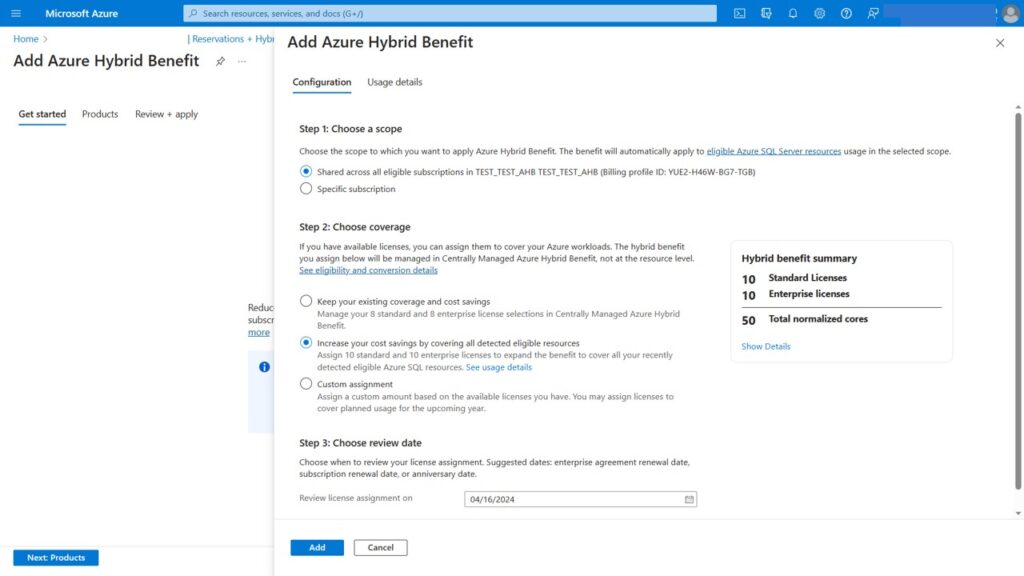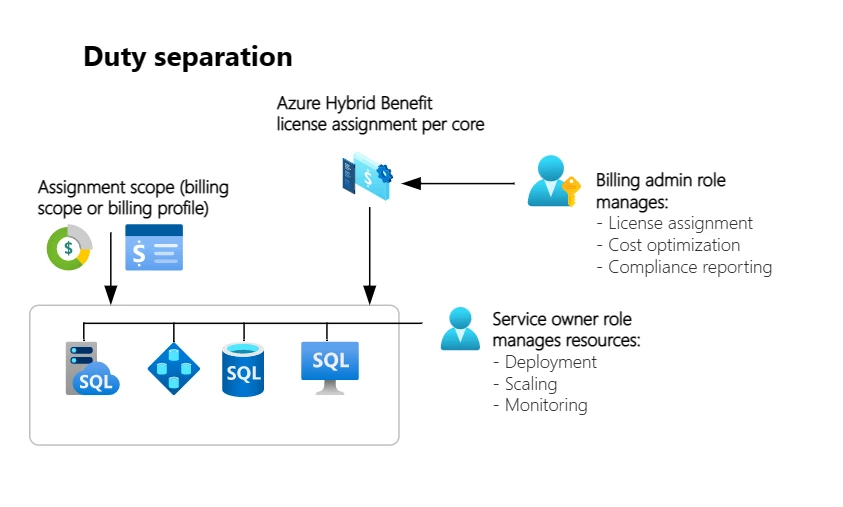Capitalize on your investments with the new centrally managed Azure Hybrid Benefit for SQL Server
Introducing the new centrally managed Azure Hybrid Benefit for SQL Server.
Today, Microsoft is pleased to announce the release of centrally managed Azure Hybrid Benefit for SQL Server, a new Azure portal feature that helps you improve SQL Server license management at multiple levels, including at account(s) and subscription levels, so you can ensure you are making the most out of your investments with the Microsoft SQL Server platform.
Having full visibility into your SQL Server estate can help optimize your costs, as it enables the ability to track your SQL Server with Software Assurance license utilization against Azure Hybrid Benefit, so you can identify additional licenses to maximize cost savings. Just to give you an idea, you can save up to 93 percent more than SQL Server on AWS Relational Database Service (RDS) by using your Software Assurance-enabled SQL Server licenses on Azure through Azure Hybrid Benefit.1

Azure Hybrid Benefit
Azure Hybrid Benefit is a licensing offer that helps you migrate and save to Azure.
Overview of Azure Hybrid Benefit
Azure Hybrid Benefit is a licensing benefit that is unique to Microsoft customers. Azure Hybrid Benefit allows you to apply your existing SQL Server licenses covered by Software Assurance for discounted rates on Azure SQL Database and Azure SQL Managed Instance licenses when you decide to move to Microsoft Azure.
Now, with the new centrally managed Azure Hybrid Benefit for SQL Server you have an easier way to leverage this benefit, as you can apply Azure Hybrid Benefit to SQL Server licenses to Azure at scale. Just one administrator can spend a few minutes assigning a single block of licenses across an entire Azure subscription or billing account, just to give you an example. And proactive notifications are available when license assignments need to be refreshed, so you can apply SQL Server Enterprise and Standard Edition core licenses together to cover Azure SQL resources and continue optimizing your costs.
An administrator can monitor Azure Hybrid Benefit utilization and directly adjust licenses assigned to Azure. For example, an administrator might see an opportunity to save more money by assigning more licenses to Azure. Then they speak with their procurement department to confirm license availability. Finally, they can easily assign the licenses to Azure and start saving.
Here’s a snapshot of how the new centrally managed Azure Hybrid Benefit for SQL Server works:

With the new centrally managed Azure Hybrid Benefit for SQL Server you can also better manage costs during usage spikes, as you can easily scale up the same resource or add more resources during temporary spikes. You don’t need to assign more SQL Server licenses (for example, closing periods or increased holiday shopping). For short-lived workload spikes, pay-as-you-go charges for the extra capacity might cost less than acquiring more licenses to use Azure Hybrid Benefit for the capacity. Managing the benefit at a scope, rather than at a resource-level, helps you to decide based on aggregate usage.
As data governance becomes paramount to businesses across industries, having control over your database licenses can also help you best respond to internal audits and other compliance requirements, as it provides a comprehensive view of your SQL Server environment. The new centrally managed Azure Hybrid Benefit for SQL Server helps you gain confidence in compliance as it increases visibility into license allocation and limits the number of roles who can apply licenses to Azure Hybrid Benefit. In the resource-level Azure Hybrid Benefit model, resource owners might select Azure Hybrid Benefit when there are no licenses available. Or they might not select the benefit when there are licenses available. Scope-level management of Azure Hybrid Benefit solves this situation. The billing admins that manage the benefit centrally are positioned to confirm with procurement and software asset management departments how many licenses are available to assign to Azure. The following diagram illustrates the point.

Learn more
More control over your estate enables you to help put your organization in a good position to sustain compliance moving forward.
This new experience is available for Microsoft customers with SQL Server Enterprise and Standard Edition core licenses with Software Assurance or core subscription licenses starting April, 26, 2023. You can access this new capability through the Azure Portal, under Cost Management, Reservations and Hybrid Benefit. First, confirm that all your SQL Server Azure Virtual Machines (VMs) are visible to you and Azure by enabling automatic registration of the self-installed SQL Server images with the Infrastructure as a Service (IaaS) extension tool. For more information, see Register multiple SQL VMs in Azure with the SQL IaaS Agent extension.
Take ownership of your investments in SQL Server and start saving with Azure Hybrid Benefit today!
Learn more about centrally managed Azure Hybrid Benefit and prepare for a successful migration plan with the Azure Migration Readiness Toolkit.
1Price performance claims based on data from a study commissioned by Microsoft and conducted by Principled Technologies in April 2022. The study compared performance and price performance between a 16 vCore, 64 vCore and 80 vCore Azure SQL Managed Instance using premium-series hardware on the business-critical service tier and the db.m6i.32xlarge, db.r5b.4xlarge and db.r5b.16xlarge offerings for Amazon Web Services Relational Database Service (AWS RDS) on SQL Server. (Continue below)
